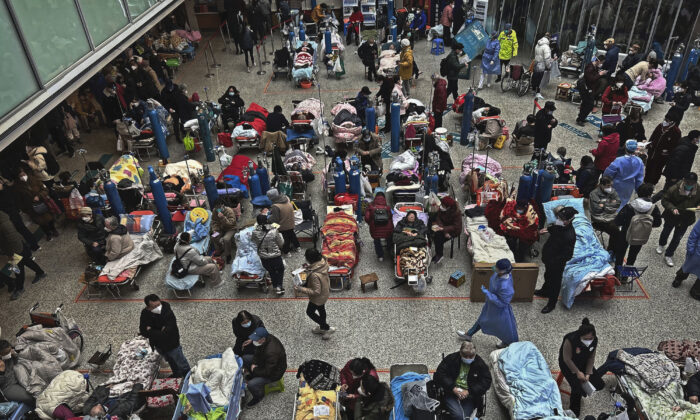Estimate suggests a huge number of deaths
By and
The Lunar New Year is the biggest and most celebrated holiday in China each year. Each year Chinese people make billions of trips across the country to visit their families during that holiday period.
However, data recently released by China’s Ministry of Transport indicate that trips during this year’s Lunar New Year—which spans 40 days—had dropped by 924 million compared to 2019, the last pre-pandemic year with no travel restrictions.
The Lunar New Year travel period starts 14 days ahead of Lunar New Year’s Eve usually in late January or early February and lasts for about 40 days.
Trips via public transportation by rail, road, water, and plane plunged 46.5 percent to 1.595 billion in the period.
The same period in 2019 saw 2.980 billion trips via public transportation, according to that year’s official data.
The ministry claimed that this year’s total trips during that period were 4.733 billion, which included 1.595 billion via public transportation and 3.138 billion in “passenger vehicle traffic via highway.” However, “passenger vehicle traffic via highway,” a new sub-category added in 2023, was not included in prior years.
In the newly released official data, the regime claimed that the “passenger vehicle traffic via highway” in 2023 was 17.2 percent higher than that of 2019 during the Lunar New Year travel period.
This means, according to the claim, the highway passenger vehicle traffic in 2019 was about 2.677 billion.
According to those numbers, the total travel volume in 2023’s Lunar holiday period was 4.733 billion (1.595 billion via public transportation + 3.138 billion in highway passenger vehicle traffic).
Meanwhile, the total travel volume in 2019’s Lunar holiday period was 5.657 billion (2.980 billion via public transportation + 2.677 billion in highway passenger vehicle traffic).
Based on the two official data sources, China saw a decline of 924 million passengers in total travel volume in 2023 compared to 2019 during the same holiday period.
Lack of Transparency
Since the COVID-19 outbreak three years ago, people have been unable to determine the true death toll in China.
In late January, amid Lunar New Year celebrations, a top Chinese health official revealed that over 80 percent of China’s population had been infected with the virus.
Despite widespread reports of leaked internal documents that suggested high death tolls in the country, the Chinese Communist Party (CCP) has continued to release official data that appears illogical and unconvincing.
Given the Chinese regime’s long history of falsifying data on almost all major disasters that have occurred, the World Health Organization (WHO) on Jan. 4 once again publicly asked Beijing to share specific and real-time data on the new outbreaks sweeping the country, reiterating the “importance of transparency.”
In a subsequent briefing, the WHO emphasized that current data released by the CCP do not reflect the true impact that COVID-19 has had on the country’s hospital admissions, acute care admissions, and especially its death toll.
Indication of Massive COVID-19 Death Toll?
The massive drop in domestic travel volume during the Lunar New Year in China could be a strong indicator of a substantial decline in the Chinese population.
The country has sustained an enormous number of COVID-19 infections and a high hospitalization rate. It has also endured 3 years of draconian restrictions and lockdowns. The zero-COVID policy delayed and even denied much-needed medical care for the sick and elderly. It also denied residents basic necessities. In some cases, people were welded inside their homes or apartment buildings.
Chinese families have a tradition to gather during the New Year, and people will travel back to their hometowns regardless of their financial conditions. If there’s less travel, it usually indicates a change in demographics.
Based on the regime’s 2019 official data, the average number of trips per person during the Lunar holiday period was 2.4. The average number was calculated by dividing the total travel volume by the country’s population below 65.
The reason to exclude those 65 years of age and above was that they are less likely to travel and are usually the ones visited by their children according to the Chinese holiday tradition.
Based on this ratio, a decline of 924 million holiday passengers could suggest a likely population decline of 385 million in the four-year period from 2019 to 2023.
Source: https://www.theepochtimes.com
Disclaimer: We at Prepare for Change (PFC) bring you information that is not offered by the mainstream news, and therefore may seem controversial. The opinions, views, statements, and/or information we present are not necessarily promoted, endorsed, espoused, or agreed to by Prepare for Change, its leadership Council, members, those who work with PFC, or those who read its content. However, they are hopefully provocative. Please use discernment! Use logical thinking, your own intuition and your own connection with Source, Spirit and Natural Laws to help you determine what is true and what is not. By sharing information and seeding dialogue, it is our goal to raise consciousness and awareness of higher truths to free us from enslavement of the matrix in this material realm.
 EN
EN FR
FR



























"Ghost cities in China" Think!
It's already begun, easily seen with eye's that can see.